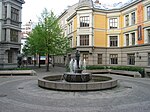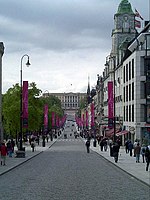2022 Oslo shooting

On 25 June 2022, two people were killed and twenty-one people were wounded in a mass shooting in Oslo, Norway. Police are treating the incident as an "act of Islamist terrorism". The target may have been the Oslo LGBTQ pride event, which was hosted by the local branch of the Norwegian Organisation for Sexual and Gender Diversity.Police arrested Zaniar Matapour, a Norwegian citizen from Sanandaj, Iran, who lived in Norway since 1991. They later confirmed that they had known of Matapour since 2015, saying that he had been radicalized into Islamic extremism. They also said he had a "history of violence and threats", as well as mental health issues. He has been charged with murder, attempted murder, and terrorism.
Excerpt from the Wikipedia article 2022 Oslo shooting (License: CC BY-SA 3.0, Authors, Images).2022 Oslo shooting
Rosenkrantz’ gate, Oslo Sentrum
Geographical coordinates (GPS) Address Website Nearby Places Show on map
Geographical coordinates (GPS)
| Latitude | Longitude |
|---|---|
| N 59.915277777778 ° | E 10.740555555556 ° |
Address
London Pub
Rosenkrantz’ gate
0164 Oslo, Sentrum
Norway
Open on Google Maps











